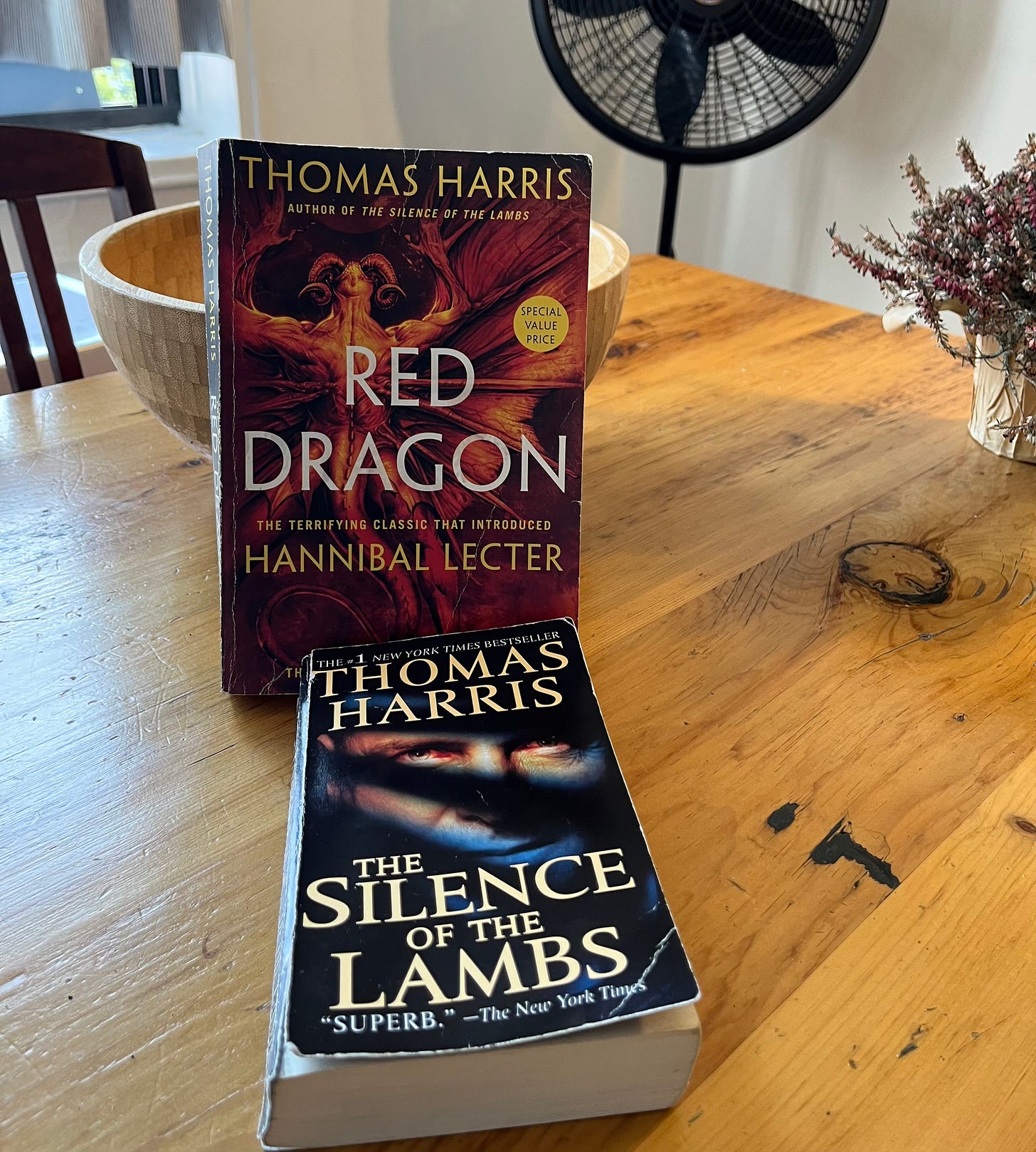Every August for the past few years, I’ve read Thomas Harris’s Red Dragon (1981) and The Silence of the Lambs (1988) back-to-back. It’s become my little goodbye-to-summer reading ritual. This year, the books got me thinking.
Red Dragon, from 1981, seems to have introduced the ‘law enforcement uses a serial killer to catch a serial killer’ trope. Commonplace as that became, Red Dragon is no less effective today, 44 years after it became a bestseller.
Francis Dolarhyde, quiet photo lab technician, has a secret life as a serial killer. Dubbed ‘the Tooth Fairy’ by the press, Dolarhyde calls himself the Red Dragon, after William Blake’s famous watercolor. The voice of Dolarhyde’s cracked psyche, the Red Dragon orders him to commit his crimes, a mental illness rooted in Dolarhyde’s gothically abusive childhood.
Jack Crawford of the FBI, with no leads on the Tooth Fairy, calls Will Graham out of retirement. Graham is a kind of serial killer empath who years ago used his special skills to lead the FBI to Dr. Hannibal Lecter (Red Dragon is Lecter’s debut), who nearly killed him. In the middle of the night, alone at the scenes of the Tooth Fairy’s crimes, Graham tries to intuit the killer’s worldview and motivation. Feeling like it’s not working, that he needs more, Graham interviews the imprisoned Lecter about the Tooth Fairy’s crimes. In pursuit of his truth, Graham has unwittingly put himself at grave risk.
The novel follows these two solitary visionaries, Will Graham and Francis Dolarhyde, opposed yet tightly bound. Each needs the other for life to make sense: Dolarhyde must terrorize the world, Graham must catch Dolarhyde. Each eschews all social bonds in pursuit of their mission; they, and they alone, truly understand each other.
Sadness at humanity’s fallen state pervades Red Dragon. Harris concludes the novel with a gut-punch three-word poem: “Shiloh doesn’t care”. Like the grass and trees on the field of Shiloh, the site of the bloodiest battle in the American Civil War, Harris suggests that evil and amorality are natural, eternal, and indifferent to our concerns.
Perfectly crafted, Red Dragon has a downbeat ending and a chilly heart. It was also a massive hit. Certainly, a follow-up was inevitable. Interestingly, you could read Harris’s more-famous sequel, The Silence of the Lambs, as a straight-up re-write (or remake, if you like) of Red Dragon.
I think it’s much more a re-do than a sequel. It’s as if Thomas Harris asked himself: What if, instead of a moody and tortured 40 year-old male genius as my hero/detective, I had a hard-working, no-nonsense, 21 year-old female FBI trainee? What would Red Dragon be like with her?
So Harris swaps Will Graham for, of course, Clarice Starling. Perhaps not wanting a pure retread, Harris then subs in Jame Gumb’s Buffalo Bill for Francis Dolarhyde’s Tooth Fairy/Red Dragon. These are one-to-one changes; the characters function exactly the same. The broad outlines of the two stories are, likewise, identical: main character is drafted by Jack Crawford to stop a serial killer; meets Dr. Lecter; chases the criminal.
The obvious difference between Starling and Graham, between Red Dragon and Silence, is Starling’s social and communal life versus Graham’s solitary genius:
Graham finds Dolarhyde by imagining himself as the killer; Starling finds Buffalo Bill by imagining herself as his victims.
Graham, shielded by his reputation as a genius, is immune to office politics and power clashes; Clarice Starling, a low-status FBI trainee and beautiful young woman, is thrust in the middle of several political battles (which she overcomes by basically being smart, honest, and kind).
Will Graham drinks at the hotel and looks at bloody photos of the crime scene; Clarice Starling notices a clothing brand common to two victims, which eventually becomes the thread (pun certainly intended!) she pulls to find Buffalo Bill.
And so on. In Red Dragon, the urge is to dominate and win, whether it's Francis Dolarhyde or Will Graham. Graham, when he finally finds what he needs to point the FBI toward Dolarhyde, savors it as a singularly satisfying intellectual achievement. He cares about the victims, sure, but he’s arguably more interested in simply outsmarting the killer.
Not Clarice Starling. She believes in and wishes to do good, whatever the cost. It’s that core belief that lets her rise above Buffalo Bill’s violence, Lecter’s amorality, and the pettiness of the powerful.
Now I think I get it: Red Dragon is dark; Silence of the Lambs finds some lightness; Red Dragon says “Shiloh doesn’t care”, Silence of the Lambs says, “ok, fine, Shiloh doesn’t care, but we care”. Red Dragon is Joy Division’s “Love Will Tear Us Apart”; Silence of the Lambs is Captain and Tennille’s “Love Will Keep Us Together”, with some tasty fills from drummer Hal Blaine. Red Dragon is a brilliantly morose graduate student; Silence of the Lambs is an adult with a job, a spouse, two kids, and a bank account, ready to do whatever it takes.
Clearly, we need both perspectives! Too much of one, we’ll lose the thread. I take them together, which I think is the idea.
Thomas Harris, with a masterful command of plot, characterization, and pacing, has given us two perfectly entertaining books that leave us with plenty to savor and consider while we buckle in, doing what we must.



Dennis Charles and Thomas Harris back to back: this is the way